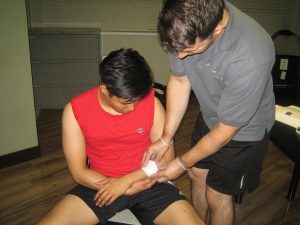Burns are usually due to radiation, heat, chemicals, electricity or sunlight. The resulting damage may be classified into three categories namely first, second and third degree burns. These all require different Burns first aid approaches. Burns first aid involves recognizing the severity and knowing how to treat the area accordingly.
First degree burn
First degree burns are usually painful, red and swollen. They also turn white upon the application of pressure and will often peel and flake after a couple of days. Treat these by first soaking in cold water and using a topical ointment like Aloe Vera. One can also take over-the-counter pain killers to ease the discomfort. If the area is larger than 3 inches wide or is in the feet, face, or genitals, seek medical attention. Such injuries usually heal in a matter of days.
Second degree

These burns cause swelling, severe pain and splotchy skin with large blisters. Treat these kinds of burns by soaking in cool water for about 15 minutes. If the area is not big, place a wet, cool towel to lower the temperature. Use an antibiotic ointment/cream that the doctor prescribes.
The burn should then be covered using a nonstick dry gauze during the burns first aid. This should be changed everyday after washing the area gently. If any symptoms of infection appear, see a doctor immediately. This injury could take several weeks to heal. However, one should seek medical attention for large second degree burns.
Third degree
Third degree burns usually damage all skin layers and have a charred/white appearance. Due to the extensive nerve damage to the skin, the burn may be painless. Such severe injuries require immediate medical attention. Don’t soak or try to remove garments stuck to the skin. You can apply a clean bandage to the area till you arrive at the hospital.
Management of other types of burns
Burns could also be due to electricity or exposure to chemicals. For the former, damage may be present in other areas of the body besides the skin surface. Due to this, one should seek medical help immediately. Wash chemical burns using lots of water. Remove any clothing that has the chemical on it. Don’t apply topical medication because it could react with the chemical agent that caused the burn. If you’re unsure of whether to seek medical help, contact your local poison center.
For steam burns, first analyze the severity. Burns First aid treatment won’t be of any help if the injury is so intense that emergency treatment is needed. If the burn has open skin, is blistered or is larger than 3 inches in diameter, seek medical help. While severe burns are usually evident, there may be inconspicuous injuries such as respiratory damage due to inhalation.
Other common burns are due to cigarettes. For such, you can follow the burns first aid procedures used to treat first degree burns. This is because they are usually not severe. Provide oral painkillers 3 to 4 times a day to alleviate the pain. Burns first aid procedures should be carried out immediately they occur in order to reduce the chance of a scar developing and to prevent infection as well.
FACT CHECK
https://www.mayoclinic.org/first-aid/first-aid-burns/basics/art-20056649
https://www.webmd.com/first-aid/thermal-heat-or-fire-burns-treatment#1
https://www.nhsinform.scot/illnesses-and-conditions/injuries/skin-injuries/burns-and-scalds
